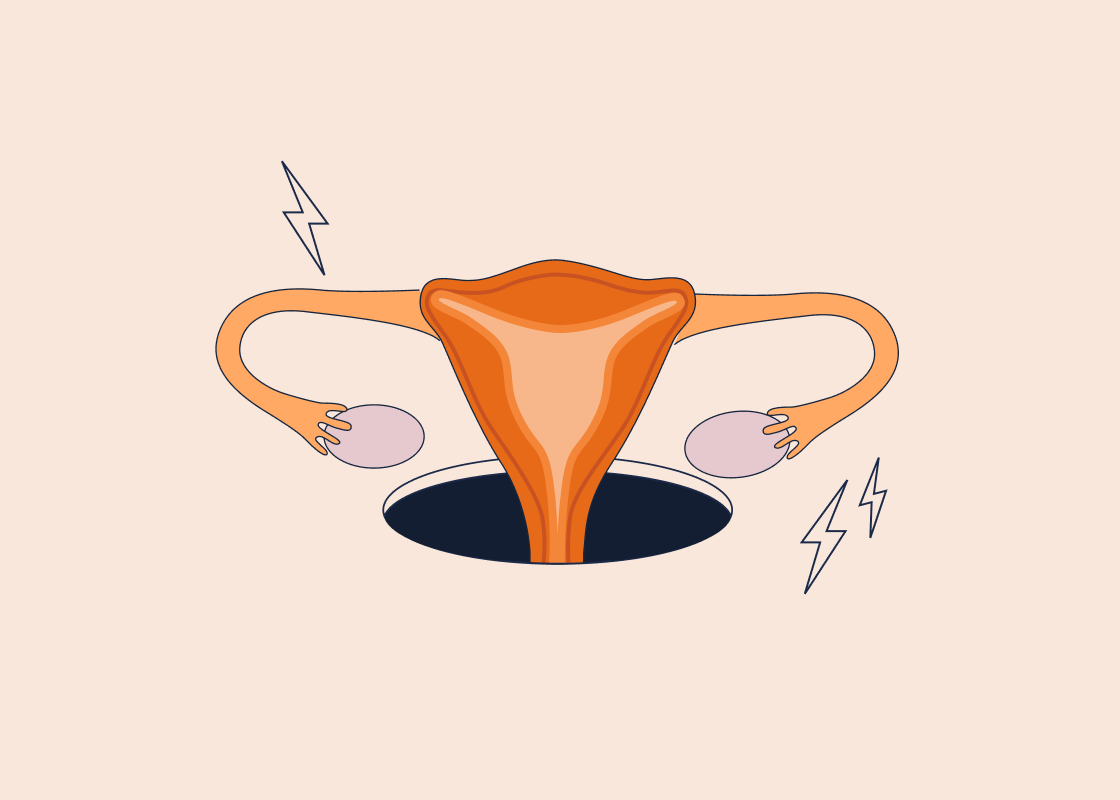The topic of STDs is shrouded in a cloud of taboo and misinformation. So we understand that talking about STDs—even more so if it involves infertility—can leave you feeling uncomfortable or vulnerable. And that's perfectly okay.
We're here to address some of the main concerns and questions you may have about STDs and your fertility.
Before we dive any deeper, let's first define what infertility is. According to the CDC, infertility is defined as the inability to get pregnant or conceive after a minimum of one year of unprotected sex [1].
In this guide, we'll explore the following:
- Which STDs or STIs can lead to infertility
- Whether treatment can restore your fertility
- What signs and symptoms to look out for that suggest you have an STI
- When you should see a doctor
- Preventative measures you can take
Let's get into it.
What Are STDs Or STIs?
STD stands for sexually transmitted disease, while STI stands for sexually transmitted infection. Both these terms are often used interchangeably. But they aren't the same thing.
STIs refer to infections caused by certain viruses, parasites, or bacteria transmitted through the exchange of bodily fluids or intimate physical contact. Despite its name, non-sexual activities may also lead to the transmission of an STI. For example, a person can transmit an HIV infection by sharing a contaminated needle [2].
On the other hand, STDs are diseases that have come about due to an STI. In this sense, all STDs begin as STIs. However, in an STD, the pathogen would have begun multiplying and destroying or disrupting the optimal function of your cells, tissues, and organs, leading to symptoms and adverse health outcomes [2].
How Do I Know If I Have An STD?
If you're concerned your symptoms may suggest an STD, the best way to have a diagnosis made is to seek the help of a trusted healthcare professional.
To diagnose your condition, your doctor will typically perform physical examinations and conduct some tests. These may include urine tests or swabs of the affected region [3].
STD screening can also help identify a possible infection if you do not experience any existing symptoms. The Centers for Disease Control and Prevention (CDC) recommends screening for specific STDs in certain populations.
According to their screening guide, all sexually-active person with uterus under 25 should be screened yearly for gonorrhoea and chlamydia. Meanwhile, people with uteruses above 25 with new or multiple sex partners should also be screened annually for gonorrhoea and chlamydia [4].
If you're unsure which tests suit you best, your doctor will be able to provide recommendations.
Can STDs Lead to Infertility?
Well, the answer is yes, STDs can lead to infertility, but only certain STDs do.
In most cases, contracting a certain STI doesn't mean your fertility will be affected. But leaving it untreated may drastically increase your chances of experiencing fertility-related issues. Hence, getting an appropriate diagnosis and prompt treatment for the condition is key to preventing infertility [5].
The primary way STDs may affect fertility is by increasing your risk of a condition called pelvic inflammatory disease (PID). PID is the infection and inflammation of the reproductive organs, including the uterus, fallopian tubes, and ovaries.
PID can be asymptomatic or may present with various symptoms, such as lower abdominal pain. If not treated adequately, PID can bring about complications such as infertility. The more times you experience PID, the higher your risk of infertility [5]. Untreated PID can also lead to long-term pelvic pain and ectopic pregnancy—a life-threatening condition where the fertilised egg implants outside the uterus [7].
According to the CDC, both gonorrhoea and chlamydia are the main preventable causes of PID. Statistics even show that around 10-15% of people with uteruses with chlamydia develop PID if left untreated [12].
The Different Types Of STDs And Their Effect On Fertility
Let's explore further in-depth which STDs may lead to infertility, and how that happens.
Chlamydia
Chlamydia is a bacterial infection and is one of the most prevalent STDs. It usually doesn't present with symptoms (asymptomatic) in people with uteruses, which is why it commonly goes undetected and untreated [5].
An untreated chlamydia infection can lead to irreversible damage to the fallopian tubes, which are tubes that transport mature eggs and connect your ovaries to your uterus [5].
This condition increases the inflammation within your fallopian tubes, causing scarring and tubal occlusion. Tubal occlusion means that your fallopian tubes become obstructed, preventing a viable egg and sperm from meeting. Persistent chlamydia infections can also impair the development and implantation of an embryo, decreasing the chances of a successful pregnancy even if an egg is fertilised [6].
Infection during pregnancy may also lead to complications such as ectopic pregnancy, stillbirth, and preterm birth [6].
Gonorrhoea
Gonorrhoea is an STD resulting from a bacterial infection. This infection is often asymptomatic.
In this condition, the Neisseria gonorrhoeae bacterium infects the mucosal membranes of your reproductive tract. This can lead to infertility in several ways. Firstly, the bacteria may attack the cells lining the surface of your fallopian tube. Hence, your fallopian tubes will no longer be able to transport a mature egg as they used to, and this heightens your risk of infertility [6].
Both chlamydia and gonorrhoea can also spread from your vagina to the other parts of your reproductive system—including the uterus and ovaries—and damage them, causing pelvic inflammatory disease (PID) [7].
Trichomoniasis
Trichomoniasis is caused by a parasite called Trichomonas vaginalis and is the most prevalent non-viral STI. Compared to other conditions, it is very much under-researched. Nonetheless, existing evidence has suggested a possible link between Trichomonas vaginalis and infertility in people with uteruses [6].
This infection can contribute to the damage and inflammation of your upper reproductive tract. Experts speculate that this parasite may facilitate the spread of other harmful bacteria and organisms throughout your uterus, fallopian tube, and ovaries, indirectly causing tubal damage and infertility [6].
Nonetheless, more research needs to be conducted to more conclusively study the effect of a Trichomoniasis infection on fertility.
Mycoplasma
The Mycoplasma genitalium infection is not as well known as other STIs. But some data has shown that it affects around 15-20% of high-risk and sexually-active people with uteruses in the US and is actually more common than gonorrhoea. Research has noted that this bacteria may be associated with tubal infertility, pelvic inflammatory disease, and ectopic pregnancy [6].
This bacteria can latch onto the cells of your reproductive tract and prompt an immune response, kickstarting the inflammation process. Plus, researchers also found that Mycoplasma genitalium can cause the cilia to swell and detach from the cells lining your fallopian tubes. Cilia are hair-like structures found in your fallopian tubes, and ciliary movement helps to carry mature eggs from the ovary to the uterus. Hence, the destruction of these cilia can reduce fertility [6].
When left untreated, a Mycoplasma genitalium infection can damage and significantly hinder the function of your fallopian tubes [6].
HPV
You may be wondering, "Is HPV an STI?"
The answer is yes. In fact, HPV is the most common STI worldwide, and most sexually-active people will be exposed to it at least once in their lifetime [5].
HPV is caused by the human papillomavirus. Most people with uteruses will clear the virus without any treatment or intervention, but in cases where the infection persists, it can cause cervical or anal cancer [5].
Research has also suggested that HPV can impact infertility in all people in several ways. For instance, this infection can affect sperm quality and motility [8].
Additionally, some research suggests that it can also interfere with the implantation of an embryo and theoretically increase the risk of a miscarriage and early pregnancy loss. Of course, more research will need to be done to confirm this association [8].
STDs and Pregnancy
STDs can impact your odds of getting pregnant. But on top of that, it may also affect your chances of having a successful and healthy pregnancy [9].
For instance, certain untreated STDs may lead to diseases for the pregnant person and increase the risk of stillbirth, low birth weight, and preterm birth. The infection can also pass on to your baby and cause eye infections and pneumonia after birth [9].
When Should I See A Doctor?
Understandably, you may be concerned about the impacts of an STD on your fertility or pregnancy. It can be extremely daunting to seek professional help and discuss this matter, but this is one of the best and safest routes to take to protect your health, fertility, and pregnancy outcomes.
It's best to see your doctor the moment you observe any symptoms that may suggest an infection, such as the following [10]:
- Any unusual or foul-smelling discharge from your genitals
- Lumps, sores, blisters, or ulcers around your genitals or anus
- Pain upon urination
- Increased urinary frequency or urgency
- Abnormal vaginal bleeding or spotting
- Itching or pain around your genital area or anus
- Genital pain before, during, or after sex
- Pelvic pain
Many STDs are treatable, and catching them in their early stages allows your doctor to recommend prompt treatment and management and prevent the infection from affecting your fertility.
Even if you do not experience any symptoms, you may still have an infection, as they can be asymptomatic. Hence, getting screened for an STD infection is key to protecting your health if you're sexually active.
If a diagnosis is made, your doctor will recommend treatment based on the type of infection, which may involve an antibiotic, antifungal, or antiviral medication [10].
How Can I Prevent STDs?
According to the evidence, the standard condom is effective in preventing the transmission of most STIs. If used correctly, the internal condom may also be useful in some instances or used as a backup method [11].
Additionally, certain vaccinations can help protect you against an STI. A popular example is the HPV vaccination, which also reduces your risk of HPV-related cervical cancer [5]. You may check with your healthcare provider to determine which vaccines are suitable for you.
Limiting the number of partners or practising monogamy (a relationship where both you and your partner exclusively have sex with each other and no one else) are some ways to mitigate or lower your risk of an STD. Of course, this may not be suitable or preferable in every case [11]. It is also important to remember that this method may reduce the risk of transmission but does not completely eliminate that risk.
Final Takeaway: STDs and Infertility
Certain STDs can negatively impact fertility, the most well-known being chlamydia and gonorrhoea. These two infections can cause pelvic inflammatory disease if left untreated, which damages your reproductive tract and reduces fertility.
Seeking timely management for an STD is the best way to preserve your wellness and fertility and safeguard the health of your (future) baby. If you don't feel comfortable talking to your family doctor about this, a good alternative would be clinics that offer confidential STD screenings.
References
-
Infertility | Reproductive Health | CDC. (n.d.). Retrieved October 8, 2022, from https://www.cdc.gov/reproductivehealth/infertility/index.htm
- Tulane University, School of Public Health and Tropical Medicine. (2020, March 16). STI vs. STD: Key Differences & Resources for Students. Tulane University. Retrieved August 25, 2022, from https://publichealth.tulane.edu/blog/sti-vs-std/
- Muralidhar S. (2015). Molecular methods in the laboratory diagnosis of sexually transmitted infections. Indian journal of sexually transmitted diseases and AIDS, 36(1), 9–17. https://doi.org/10.4103/0253-7184.156686
- Centers for Disease Control and Prevention. (2021, December 14). Which STD Tests Should I Get? | Prevention | STDs | CDC. CDC. Retrieved August 29, 2022, from https://www.cdc.gov/std/prevention/screeningreccs.htm
- Van Gerwen, O. T., Muzny, C. A., & Marrazzo, J. M. (2022). Sexually transmitted infections and female reproductive health. Nature microbiology, 7(8), 1116–1126. https://doi.org/10.1038/s41564-022-01177-x
- Tsevat, D. G., Wiesenfeld, H. C., Parks, C., & Peipert, J. F. (2017). Sexually transmitted diseases and infertility. American journal of obstetrics and gynecology, 216(1), 1–9. https://doi.org/10.1016/j.ajog.2016.08.008
- Das, B. B., Ronda, J., & Trent, M. (2016). Pelvic inflammatory disease: improving awareness, prevention, and treatment. Infection and drug resistance, 9, 191–197. https://doi.org/10.2147/IDR.S91260
- Pereira, N., Kucharczyk, K. M., Estes, J. L., Gerber, R. S., Lekovich, J. P., Elias, R. T., & Spandorfer, S. D. (2015). Human Papillomavirus Infection, Infertility, and Assisted Reproductive Outcomes. Journal of Pathogens, 2015, 1–8. https://doi.org/10.1155/2015/578423
- Wynn, A., Bristow, C. C., Cristillo, A. D., Murphy, S. M., van den Broek, N., Muzny, C., Kallapur, S., Cohen, C., Ingalls, R. R., Wiesenfeld, H., Litch, J. A., Morris, S. R., & Klausner, J. D. (2020). Sexually Transmitted Infections in Pregnancy and Reproductive Health: Proceedings of the STAR Sexually Transmitted Infection Clinical Trial Group Programmatic Meeting. Sexually transmitted diseases, 47(1), 5–11. https://doi.org/10.1097/OLQ.0000000000001075
- Garcia, M. R., & Wray, A. A. (2022). Sexually Transmitted Infections. In StatPearls. StatPearls Publishing.
- Steen, R., Wi, T. E., Kamali, A., & Ndowa, F. (2009). Control of sexually transmitted infections and prevention of HIV transmission: mending a fractured paradigm. Bulletin of the World Health Organization, 87(11), 858–865. https://doi.org/10.2471/blt.08.059212
- Infertility & STDs - STD Information from CDC. (n.d.). Retrieved October 8, 2022, from https://www.cdc.gov/std/infertility/default.htm




